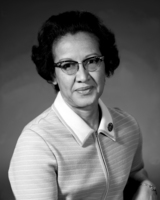 | Back to e-WV
| Back to e-WV
 The West Virginia Encyclopedia
The West Virginia Encyclopedia
 | Back to e-WV
| Back to e-WV
 The West Virginia Encyclopedia
The West Virginia Encyclopedia

Katherine Coleman Goble Johnson (August 26, 1918 – February 24, 2020), a NASA mathematician, was born in White Sulphur Springs. The local segregated schools offered schooling only to eighth grade for Black children. Johnson left home to attend an African-American high school associated with West Virginia State College (now University), and completed her secondary school course work at the age of 13. She began college at West Virginia State the next year and graduated in 1937, at age 18, with a bachelor’s degree in mathematics and French. In 1939, she married James Francis Goble; together, they had three daughters – Constance, Joylette, and Katherine. After graduation, she worked as a teacher of mathematics until she began her work for the space program in the 1950s.
Despite the obstacle of being an African-American woman in a male-dominated field, she persevered and thrived. She began working with the National Advisory Committee for Aeronautics, the agency that preceded the National Aeronautics and Space Administration (NASA), in 1953, as a “computer” doing complex analysis and calculations. Following her first husband’s death from a brain tumor in 1956, she married Lt. Colonel James A. Johnson in 1959. From 1958 to 1986, when she retired from NASA, Johnson was an aerospace technologist. Her work was crucial in calculating the 1961 trajectory for Alan Shepard’s historic suborbital flight. In 1962, for John Glenn’s orbit around the Earth, she verified calculations made for the first time by electronic computers. In 1969, she calculated the Apollo 11 trajectory to the Moon. Johnson’s successful calculations were central to many prominent American space flights during her tenure at NASA.
Johnson has received many awards, including honorary doctoral degrees. She has authored or co-authored 26 articles in her field. A pioneer for African-American women in science, math, and technical fields, she continues to be a vigorous advocate for young girls and education. In 2015, Johnson received the Presidential Medal of Freedom from President Obama for her accomplishments in the field of mathematics and science. In 2016, NASA announced the Katherine G. Johnson Computational Research Facility at the Langley Research Center in Hampton, Virginia.
In September 2016, Margot Lee Shetterly’s book Hidden Figures: The American Dream and the Untold Story of the Black Women Mathematicians Who Helped Win the Space Race was released. The book follows the interwoven accounts of Johnson and three other Black women — including Dorothy Vaughan, who grew up in Morgantown — who participated in some of NASA’s greatest successes over three decades. On Christmas Day, 2016, 20th Century Fox released the movie Hidden Figures, based on the book and with actress Taraji Henson in the role of Johnson. On August 25, 2018, West Virginia State University unveiled a statue of Johnson on campus and dedicated the Katherine Coleman Goble Johnson Scholarship to aid young people studying science, technology, engineering and mathematics. On December 11, a NASA software facility in Fairmont was renamed the Katherine Johnson Independent Verification and Validation Facility. The facility ensures that all of NASA’s critical safety mission software is safe.
Katherine Johnson died at the age of 101 in Hampton, Virginia. In 2023, her historical collection was donated to the West Virginia and Regional History Center at West Virginia University. It consists of notebooks, photographs, correspondence, memorabilia, awards, and other materials.
In 2021, Northrup Grumman named one its NG-15 Cygnus robotic spacecraft, which supply the International Space Station, the S.S. Katherine Johnson. In October 2023, the National Aviation Hall of Fame announced Johnson as one of its 2024 inductees.
Written by Kelly Doyle
Warren, Wini. Black Women Scientists in the United States. Indiana University Press, 1999.
The White House. President Obama Names Recipients of the Presidential Medal of Freedom, 16 Nov. 2015.
Shetterly, Margot Lee. Hidden Figures: The American Dream and the Untold Story of the Black Women Mathematicians Who Helped Win the Space Race. New York: Morrow, 2016.